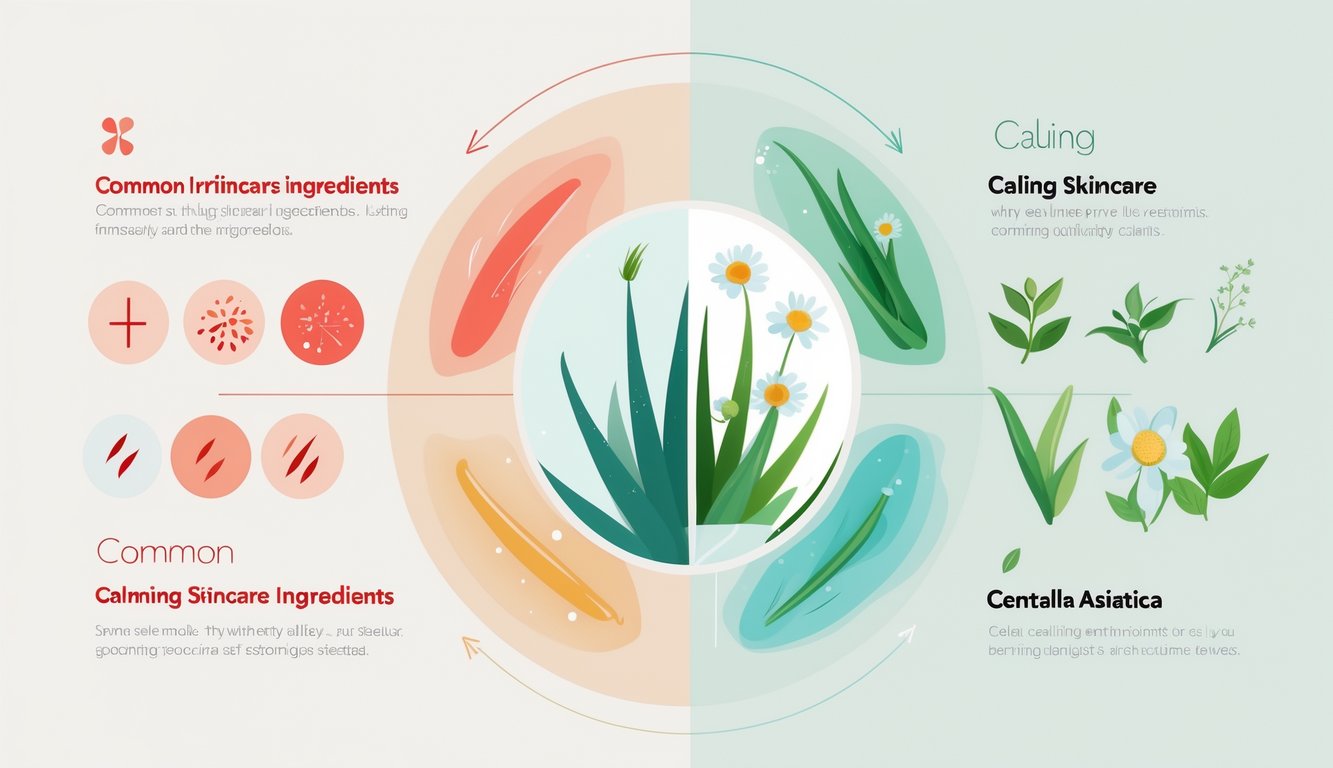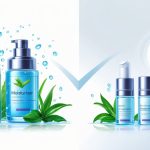Skincare Ingredient Swaps Instantly Calming Redness the Moment You Try Them
Best Calming Skincare Ingredients to Replace Irritants

Swapping out whatever’s making my skin mad (toner, water, who even knows anymore) for stuff that doesn’t yell at my face usually means fewer new red patches. I’m not a chemist, but at this point, the ingredient list is basically a “choose your own adventure” where “soothe” is the only ending I even want.
Centella Asiatica and Cica for Instant Relief
Centella Asiatica—cica, tiger grass, whatever—has become my emergency button. There’s always some stat about terpenoids, but when my cheeks are going nuclear, I don’t care. Most “Cica” creams are less irritating than almost anything else, except maybe squalane, but squalane’s kind of boring.
The point is, it calms things down fast, especially if I’ve accidentally nuked my skin with acids. Cica’s in half the “repair” creams at the pharmacy. If I got a dollar for every new K-beauty cica mask, I’d have a pile of cica masks and, I don’t know, maybe a snack.
Times I grab Cica stuff:
- After waxing or threading my upper lip (the redness is never cute)
- When I overdo retinol
- Random seasonal dryness from blasting the heater
(seriously, why does dry air and angry skin go together?)
Colloidal Oatmeal’s Soothing Power
This is where things get weirdly mushy—literally. Colloidal oatmeal is thrown around like an old-school remedy, and once my friend tried making a mask with breakfast oats and her shower was never the same. In the store, it’s just finely ground and mixed in creams. Not fun, but practical. It shows up in eczema, hives, bug bite stuff—if it itches, there’s probably an oatmeal cream for it.
It doesn’t sting, which is rare for anything meant to calm down a rash. Apparently, it forms a film over your skin, keeps out irritants, locks in moisture, and doesn’t fight with actives like niacinamide or ceramides.
Colloidal oatmeal creams don’t look cool or smell amazing, but they work. I’ve mixed it with aloe before. Oatmeal and aloe together—my skin basically took a nap.
Azelaic Acid’s Redness-Reducing Effects
Azelaic acid—okay, no one brings it up until they’re desperate, and then suddenly it’s all over every group chat. I mean, this stuff basically collects dust on the pharmacy shelf while everyone’s busy chasing trendier serums, but quietly, it just does its thing for redness and those weird little bumps. And, yeah, it’s not just for redness; it’s got a thing for dark spots and breakouts too, apparently.
Whenever I bother a dermatologist about “rosacea stuff,” azelaic pops up in, like, the first three minutes. I like that it doesn’t bleach my towels or turn my eyelids into sandpaper—honestly, that’s enough for me some mornings. Also, it doesn’t freak out when I slap on sunscreen after, so I don’t have to plan my routine like I’m defusing a bomb.
When do I reach for azelaic acid?
- Red, bumpy leftovers from old breakouts
- Patches that basically hiss if I even think about vitamin C
- That “is it rosacea or just my face being weird” thing—still no clue
Unrelated, but my cat insists on sitting smack in the middle of the bathroom counter while I do skincare. Sometimes I skip a step just so she won’t try to lick it. Priorities.
Licorice Root Extract for a Calmer Complexion
Licorice root extract always sounds like something that belongs in a candy aisle, right? But here we are, slapping it on our faces hoping for less redness. It’s supposed to help with dark spots and hyperpigmentation, but honestly, I just care that it chills out my face after a too-hot shower. I had this one serum—sticky, smelled sort of like old tea—my skin stopped yelling at me overnight. Was that a fluke? Probably, but I’ll take it.
Supposedly, it blocks whatever signals make your skin go red. Science says so, I guess. I just like that it calms that burning feeling when my allergies go nuts. It’s usually gentle, which is wild, since most “brightening” stuff just picks a fight with my skin barrier.
Pro-tip table:
| What I ditched | What I use with Licorice Extract |
|---|---|
| Vitamin C (the spicy kind) | Licorice root + niacinamide serum |
| Scented toner | Calming toner with licorice extract |
| Hydroquinone (no thanks) | Gentle fade lotion with licorice |
Here’s a thing: sometimes “calming” just smells like, well, nothing. That’s how I know it’s probably working better than the fancy stuff.
Moisturizers That Help Calm and Protect
I grab a moisturizer and instantly regret it at least once a month. That time I smeared minty hand cream on my face—never again. Calming down redness never feels fast, and half the time I’m reading ingredient lists that look like a spelling test. Ceramides, panthenol—stuff I never cared about until my cheeks went nuclear. My friend swears cucumbers are magic but only on her eyelids, not her salad. Sometimes I wonder if moisturizer chemists have ever had a rash.
Ceramides for Restoring the Skin Barrier
Ceramides. They’re these waxy molecules that show up in so many creams now, it’s almost suspicious. They patch up the skin barrier—like slapping tape on a cracked phone, but, you know, for your face. My barrier just disappears after a rough night or, like, any new acid. Once it’s gone, water just peaces out. Cold pizza leftovers didn’t help, in case you’re curious.
The thick creams with loads of ceramides—CeraVe, Vanicream, whatever’s on sale—feel like armor. No sting, no drama, just boring but in a good way. Apparently, ceramides work best when my face is still a bit damp (found that out way too late). If your face burns after cleansing, just pile this stuff on. No perfume, no colors, nothing cute—kind of love that.
Quick facts:
- Best for: Dry, wrecked skin
- Does: Patches up barrier, keeps water in
- When: Right after washing, before you dry out
Glycerin and Panthenol for Deep Hydration
Glycerin is everywhere in “for dry skin” stuff—feels a little sticky, not gonna lie, but I sort of like it? Like syrup, but not gross. Panthenol’s just vitamin B5, but brands love to switch up the names. I never know which one I’m buying, but they’re both in those “hydrating” creams next to travel deodorant at the drugstore.
Sometimes my skin shrivels up like an old grape. Glycerin pulls in water (so they say), and panthenol calms down dry, angry patches. Panthenol’s in burn ointments, so maybe that’s why it helps. Don’t expect miracles, though—my cheeks still flush if I walk outside in January.
Perks:
- Makes rough skin feel less like sandpaper
- Softens that tight, post-shower feeling
- Doesn’t break me out—except that one time with my cousin’s ancient lotion, but we don’t talk about that
Products with Aloe Vera and Cucumber
Aloe vera stuff always screams “summer” to me. Is it soothing? Sometimes. Other times it smells like a janitor’s closet. Real, plain aloe or the less-fake versions usually calm my cheeks when they’re having a meltdown. Dermatologists love to pop up on TV talking about aloe, or allantoin, or whatever I can’t pronounce.
Cucumber’s just everywhere. I tried real cucumber slices once—sticky, weird, but kind of fun. The gels with cucumber extract feel cool, maybe just because they’re cold? My skin just drinks it up, no residue, so I’ll use it ten times a day if I’m bored. Just skip the heavy, perfumed ones.
Quick hits:
- Aloe vera: Calms burned or cranky skin
- Cucumber extract: Cools, takes down the heat
- Look for: Fragrance-free, boring labels



